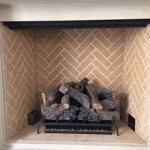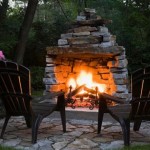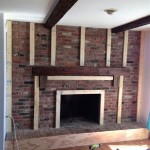Tile Around Fireplace Insert Ideas: Enhancing Aesthetics and Functionality
Fireplace inserts offer an efficient and appealing way to supplement home heating and create a focal point in a living space. While the insert itself is an important component, the surrounding area provides an opportunity to customize the fireplace and integrate it seamlessly with the existing décor. Tile selection plays a significant role in achieving this integration, offering diverse possibilities in terms of style, color, texture, and performance. This article explores various tile ideas for surrounding a fireplace insert, considering both aesthetic and practical aspects.
Understanding the Considerations for Tile Selection
Selecting the appropriate tile for a fireplace surround involves careful consideration of various factors. One of the primary concerns is heat resistance. The area surrounding a fireplace insert can experience significant temperature fluctuations, especially directly above the insert. Tiles must be able to withstand these temperature changes without cracking, warping, or discoloration. Porcelain and ceramic tiles are generally suitable due to their inherent heat resistance; however, specific ratings should be consulted to ensure compatibility with the expected temperatures. Natural stone, such as granite or marble, can also be used, but the specific type and its porosity should be carefully assessed.
Another critical factor is the overall aesthetic. The tile should complement the style of the fireplace insert, the surrounding room, and the homeowner's personal preferences. Consider the color palette, the desired texture, and the overall design scheme. A modern fireplace insert might benefit from sleek, minimalist tiles, while a more traditional insert could be enhanced by classic brick or natural stone. Size and shape also play a role; larger tiles can create a more expansive feel, while smaller tiles offer opportunities for intricate patterns. The grout color should also be carefully chosen as it can have a marked impact on the finished visual.
Finally, consider ease of maintenance and cleaning. Fireplaces can produce soot and ash, which can accumulate on the surrounding surfaces. Tiles that are easy to clean and resistant to staining will simplify upkeep and maintain the fireplace's appearance over time. Smooth, non-porous tiles are generally easier to clean than textured or porous tiles. Sealing natural stone tiles is recommended to prevent staining and moisture absorption. A regular cleaning schedule will also help to prevent the buildup of soot and grime.
Exploring Different Tile Materials and Styles
The market offers a wide range of tile materials, each with its unique characteristics and aesthetic appeal. Porcelain tiles are a popular choice due to their durability, heat resistance, and versatility. They are available in a vast array of colors, patterns, and textures, including options that mimic natural stone or wood. Porcelain tiles are also relatively easy to clean and maintain, making them a practical choice for a fireplace surround.
Ceramic tiles are another common option, offering a cost-effective alternative to porcelain. While ceramic tiles are generally less durable and less heat-resistant than porcelain, they are still suitable for fireplace surrounds, especially if the area is not exposed to extreme temperatures. Ceramic tiles are also available in a wide range of colors, patterns, and styles, allowing for considerable design flexibility.
Natural stone tiles, such as granite, marble, slate, and travertine, offer a luxurious and sophisticated look. Each type of stone has its unique characteristics and aesthetic appeal. Granite is known for its durability and heat resistance, while marble is prized for its elegant veining and polished finish. Slate provides a rustic, textured appearance, and travertine offers a warm, earthy tone. However, natural stone tiles can be more expensive than porcelain or ceramic tiles, and they may require more maintenance, including sealing to prevent staining and moisture absorption.
Glass tiles can add a touch of elegance and sophistication to a fireplace surround. They are available in a variety of colors, shapes, and sizes, and they can be used to create intricate mosaics or simple, minimalist designs. Glass tiles are also easy to clean and resistant to staining, but they may not be as durable as porcelain or ceramic tiles. They also require a different type of thinset mortar during installation.
Brick veneer offers a classic and timeless look, evoking the traditional charm of a brick fireplace. Brick veneer is thinner and lighter than traditional brick, making it easier to install and ideal for use as a decorative facing. It is also more heat-resistant than many other materials, providing a safe and durable option for a fireplace surround.
Design Ideas for Fireplace Tile Surrounds
The design possibilities for fireplace tile surrounds are virtually limitless. A minimalist approach might involve using large-format porcelain tiles in a neutral color, such as white, gray, or beige. This creates a clean, modern look and allows the fireplace insert to take center stage. The grout lines should be kept as thin as possible to minimize visual distraction.
For a more traditional look, consider using natural stone tiles, such as marble or travertine. These materials add warmth and elegance to the room, and they can be paired with decorative molding or a custom mantel. A herringbone pattern using smaller tiles can add visual interest and texture.
A rustic design can be achieved using slate or brick veneer. These materials provide a natural, textured appearance that complements a cozy, inviting living space. Consider using a rough-hewn wood mantel to complete the look. A dark grout color will accentuate the texture of the slate or brick.
A contemporary design might incorporate glass tiles or metallic tiles. These materials add a touch of glamour and sophistication to the fireplace surround. Consider using a mosaic pattern or a geometric design to create a unique focal point. LED lighting can be used to highlight the tile and create a dramatic effect.
For a bolder statement, consider using patterned tiles or colorful tiles. These materials can add personality and visual interest to the fireplace surround. Consider using a contrasting grout color to accentuate the pattern. Be mindful of the overall design scheme and ensure that the tile complements the other elements in the room.
Regardless of the chosen style, ensure the measurements are accurate and the installation is performed correctly. Incorrect installation can lead to uneven surfaces, loose tiles, and potential fire hazards.
Installation Considerations and Best Practices
Proper installation is crucial for ensuring the longevity and safety of a tiled fireplace surround. Before beginning the installation process, carefully prepare the surface by cleaning and leveling it. Remove any existing paint, wallpaper, or debris that could interfere with the adhesion of the tile. If the surface is uneven, apply a layer of cement backer board to create a smooth, level base.
Select a suitable thin-set mortar that is specifically designed for the type of tile being used. Follow the manufacturer's instructions carefully when mixing the mortar. Apply the mortar evenly to the back of the tile using a notched trowel, ensuring that there are no gaps or voids. Press the tile firmly onto the prepared surface, using spacers to maintain consistent grout lines.
After the mortar has dried, apply grout to the spaces between the tiles. Choose a grout color that complements the tile and the overall design scheme. Follow the manufacturer's instructions carefully when mixing and applying the grout. Use a grout float to press the grout firmly into the joints, and then wipe away any excess grout with a damp sponge.
Finally, seal the grout lines with a grout sealer to protect them from staining and moisture absorption. This will help to keep the grout looking clean and new for years to come. Apply the sealer according to the manufacturer's instructions, and allow it to dry completely before using the fireplace.
When working with natural stone tiles, it is essential to seal the tiles before and after installation. This will help to protect the stone from staining and moisture absorption. Use a high-quality stone sealer that is specifically designed for the type of stone being used. Apply the sealer according to the manufacturer's instructions, and allow it to dry completely before using the fireplace.
If you are not comfortable with installing tile yourself, it is best to hire a professional tile installer. A professional installer will have the experience and expertise to ensure that the job is done correctly and safely.
Ultimately, the selection and installation of tile around a fireplace insert is a significant design choice that can greatly enhance both the aesthetic appeal and practical functionality of the fireplace area. Careful planning and meticulous execution are required to achieve a successful outcome.

Tiled Fireplace Ideas To Cozy Up Your Space Arizona Tile

Fireplace Tile Inspirations Add Warmth Charm And Style To Your Home Apollo

Fireplace Tile Ideas Designs To Inspire You

Fireplace Tile Ideas Designs To Inspire You

Fireplace Tile Stone Ceramic More The

Painting Fireplace Tile The Ultimate Guide Jessica Welling Interiors

Painting Fireplace Tile The Ultimate Guide Jessica Welling Interiors

Modern Fireplace Wall Surround Tiles The Tile

Diy Fireplace Makeover With Vinyl Tiles Sew Much Ado

Hot Fireplace Tile Trends Bedrosians Stone
Related Posts








